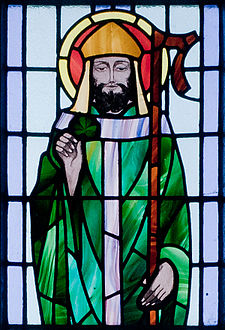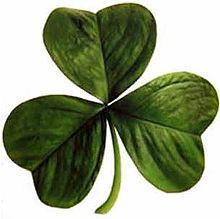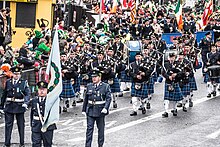Aldaw ni Santo Patrick
| Saint Patrick's Day | |
|---|---|
 Saint Patrick depicted in a stained-glass window at Saint Benin's Church, Ireland | |
| Opisyal na pangaran | Saint Patrick's Day |
| Inaapod man na | |
| Pigseselebrar kan |
|
| Klase | Ethnic, national, Christian |
| Importansya | Feast day of Saint Patrick, commemoration of the arrival of Christianity in Ireland[5][6] |
| Petsa | 17 March |
| Mga selebrasyon |
|
| Mga pag-obserba | Christian processions; attending Mass or service |
An aldaw ni Santo Patrick, o an Pista ni Santo Patrick (Irish: Lá Fhéile Pádraig, lit. 'the Day of the Festival of Patrick'), sarong relihiyoso asin pangkulturang holiday na sineselebrar kan 17 Marso, an tradisyonal na petsa nin kagadanan ni Santo Patrick (c . 385 – c. 461), an panginot na patron santo kan Ireland.
Aldaw nin Santo Patrick ginibo nang opisyal na aldaw sa kapiyestahan Kristiano kan amay na ika - 17 siglo asin siniselebrar kan Iglesia Katolika, an Anglicanong Komunyon (espesyalmente iyo an Iglesya nin Irlandia), Simbahan Ortodokso sa Sirangan, asin an Luterano. aldaw minaselebrar kan [7] Patrick asin sa pag-abot nin Kristiyanidad sa Irlandia, asin, bilang kadagdagan, sineselebrar an pamanang lahi asin kultura kan Irish sa pankagabsan. [8] mga pag - selebrar an pampublikong mga parada asin kapiestahan, céilithe, saka pagsulot nin berdeng gubing o ishamrocks. [9][10] Kristiyano [11] kabilang sa liturgical denominasyon nag-aatender man sa pansimbahanes.[1] asin historikal ining mga pangangalad kan Lenten dapit sa pagkakan asin pag - inom nin arak hinali para sa aldaw, na iyo an nagpakusog asin nagpaurog kan tradisyon kan piyesta nin inumon na pangarak.[7][8][1][2]
Santo Patrick
[baguhon | baguhon an source]Santo Patrick sarong ika-5ng siglo Romano-Bikol na Kristiyanong misyonero asin Obispo sa Irlandya. kadaklan kan bisto manongod ki Saint Patrick hale sa Deklarasyon, na soboot isinurat ni Patriarka mismo. na siya namundag sa Britanyang Romano kan ikaapat na siglo, sa sarong mayaman na pamilya nin Roman Britain. saiyang ama sarong deacon asin an saiyang lolo saserdote sa Kristianong simbahan. sa Deklarasyon, kan edad na kag-anom, siya dinukotan nin mg aIrish raider asin dinara bilang oripon sa Gaelic Ireland. kaiyan na anom na taon siang nagtrabaho duman bilang pastor asin sa panahon na ini nanompongan nia an Dios. Deklarasyon nagsasabi na sinabihan nin Dios si Patrick na dumulag pasiring sa baybayon, kun saen naghahalat an barko tanganing iuli sia. na magpuli si Patrick,
sa tradisyon, nagbalik si Patrick sa Irlandia tanganing kombertiron an pagan Irish sa Kristianismo. kan Deklarasyon na dakol na taon siang nag - ebanghelyo sa amihanan na kabangaan nin Irlandia asin rinibo an kinompuwesto nia.
Pag- abot nin panahon, an mga paghihingoa ni Patrick nagin talinhaga na dian sia nagtulod sa "mga panuwakan", paganong gibo, hale sa Irlandia, apisar kan bagay na dai aram na mag - istar sa rehion na iyan an aktuwal na halas.
tradisyon nangangaputan na siya nagadan kan 17 Marso asin ilinubong sa Downpatrick. mga nagsurunod na siglo, dakol na osipon an nagtalubo sa palibot ni Patrick asin siya nagin mayor na santo kan Irlandya.
Pagselebrar asin mga tradisyon
[baguhon | baguhon an source]

Modernong kapanahonan
[baguhon | baguhon an source]

Kan 1903, an aldaw ni Santo Patrick naging sarong opisyal na pampublikong holiday sa Ireland huli sa Bank Holiday (Ireland) Act 1903, sarong akto nin parliament kan United Kingdom na ipinabisto nin Irish MP na si James O'Mara.
Toltolan
[baguhon | baguhon an source]- ↑ Bolton, Doug (16 March 2016). "One Irish creative agency is leading the charge against 'St. Patty's Day'". The Independent. https://www.independent.co.uk/life-style/gadgets-and-tech/news/st-patricks-day-2016-pattys-day-name-google-chrome-extension-a6935141.html. "That's the thinking behind the No More Patty Google Chrome extension, created by Dublin-based creative agency in the Company of Huskies. The extension can be installed in a few clicks, and automatically replaces every online mention of the "very wrong" 'Patty' with the "absolutely right" 'Paddy'."
- ↑ Jenkins, Aric (15 March 2017). "Why Some Irish People Don't Want You to Call It St. Patty's Day". Time. https://time.com/4703066/st-patricks-day-paddys-pattys-dublin-ireland/.
- ↑ "Is It "St. Patrick's Day" Or "St. Patricks Day"?". dictionary.com. 17 March 2021. Archived from the original on 18 March 2020. Retrieved 28 March 2020. Unknown parameter
|url-status=ignored (help) - ↑ Jordan Valinsky. (8 January 2015). "Dublin Airport would like to remind you it's St. Paddy's Day, not St. Patty's Day". The Week. https://theweek.com/speedreads/456377/dublin-airport-like-remind-st-paddys-day-not-st-pattys-day.
- ↑ Ritschel, Chelsea; Michallon, Clémence (17 March 2022). "What is the meaning behind St Patrick's Day?". The Independent (in English). Retrieved 17 March 2022.
The day of celebration, which marks the day of St Patrick’s death, is a religious holiday meant to celebrate the arrival of Christianity in Ireland, and made official by the Catholic Church in the early 17th century. Observed by the Catholic Church, the Anglican Communion, the Eastern Orthodox Church, and the Lutheran Church, the day was typically observed with services, feasts and alcohol.
- ↑ Ariel, Shlomo (17 April 2018). Multi-Dimensional Therapy with Families, Children and Adults: The Diamond Model (in English). Routledge. ISBN 978-1-351-58794-5.
In many culture, identity perception is supported by constitutive myths, traditions and rituals (e.g. the Jewish Passover, the myth of the foundation of Rome [the tale of Romulus and Remus] and St. Patrick's Day, which commemorates the arrival of Christianity to Ireland and celebrates the heritage and culture of the Irish in general).
- ↑ 7.0 7.1 Willard Burgess Moore (1989). Circles of Tradition: Folk Arts in Minnesota
 . Minnesota Historical Society Press. p. 52. ISBN 9780873512398. Retrieved 13 November 2010.
. Minnesota Historical Society Press. p. 52. ISBN 9780873512398. Retrieved 13 November 2010. In nineteenth-century America it became a celebration of Irishness, more than a religious occasion, though attending Mass continues as an essential part of the day.
- ↑ 8.0 8.1 Willard Burgess Moore (1989). Circles of Tradition: Folk Arts in Minnesota
 . Minnesota Historical Society Press. p. 52. ISBN 9780873512398. Retrieved 13 November 2010.
. Minnesota Historical Society Press. p. 52. ISBN 9780873512398. Retrieved 13 November 2010. The religious occasion did involve the wearing of shamrocks, an Irish symbol of the Holy Trinity, and the lifting of Lenten restrictions on drinking.
- ↑ James Terence Fisher (30 November 2007). Communion of Immigrants: A History of Catholics in America. Oxford University Press. ISBN 9780199842254. Archived from the original on 6 October 2015. Retrieved 13 November 2010.
The 40-day period (not counting Sundays) prior to Easter is known as Lent, a time of prayer and fasting. Pastors of Irish- American parishes often supplied "dispensations" for St. Patrick s Day, enabling parishioners to forego Lenten sacrifices in order to celebrate the feast of their patron saint.
- ↑ Nagle, John (2009). Multiculturalism's Double-Bind. Ashgate Publishing. ISBN 978-0-754-67607-2. Archived from the original on 19 August 2020. Retrieved 13 November 2010.
Like many other forms of carnival, St. Patrick's Day is a feast day, a break from Lent in which adherents are allowed to temporarily abandon rigorous fasting by indulging the forbidden. Since alcohol is often proscribed during Lent the copious consumption of alcohol is seen as an integral part of St. Patrick's day.
- ↑ Barth, Edna (2001). Shamrocks, Harps, and Shillelaghs: The Story of the St. Patrick's Day Symbols. Sandpiper. p. 7. ISBN 0618096515. Archived from the original on 21 November 2015. Retrieved 13 November 2010.
For most Irish-Americans, this holiday (from holy day) is partially religious but overwhelmingly festive. For most Irish people in Ireland the day has little to do with religion at all and St. Patrick's Day church services are followed by parades and parties, the latter being the best attended. The festivities are marked by Irish music, songs, and dances.
